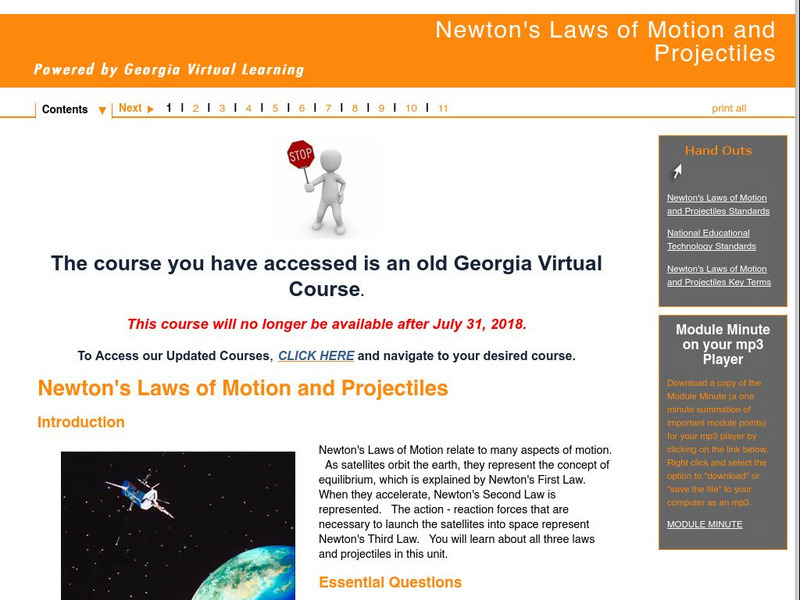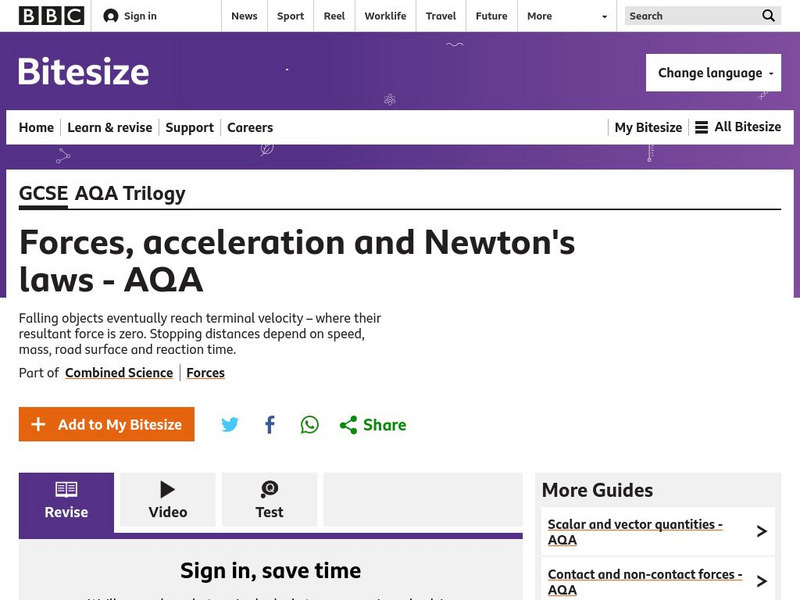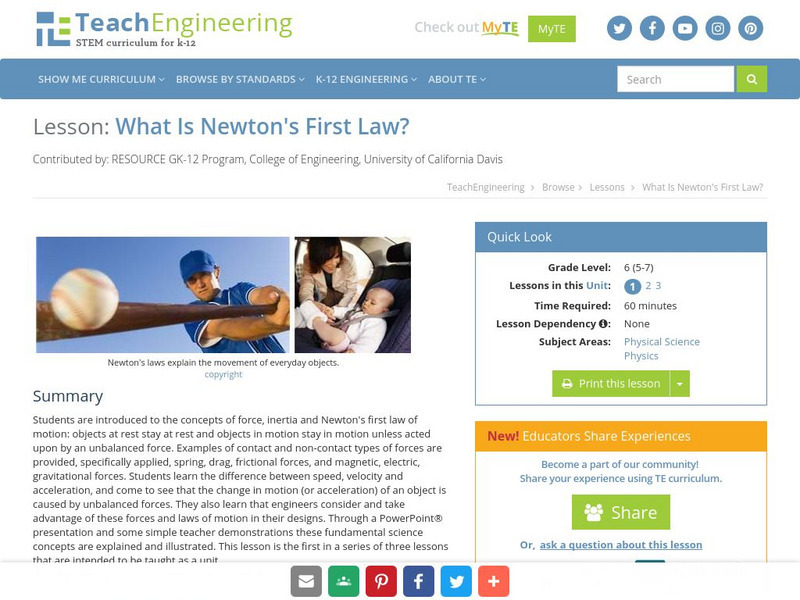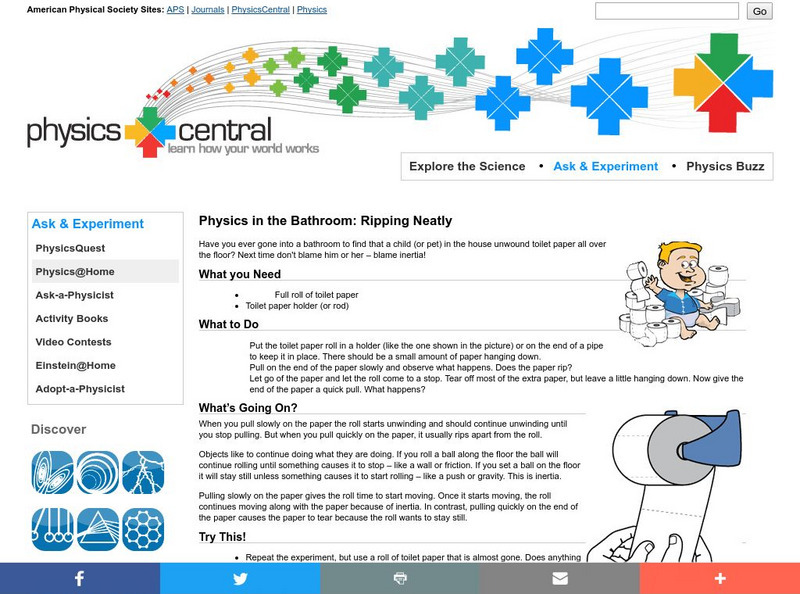Physics Classroom
The Physics Classroom: Newton's Laws
A four-lesson e-textbook covering topics in Newton's Laws. Tutorials include informational text,animations, interactive activities, and quick, interactive comprehension checks throughout the lessons.
Georgia Department of Education
Ga Virtual Learning: Newton's Laws of Motion and Projectiles
Through informational text, interactive activities, practice problems, online labs, virtual simulations, and video clips, students learn about Newton's Laws of Motion.
TeachEngineering
Teach Engineering: What Are Newton's Laws?
Through a series of three lessons and one activity, students are introduced to inertia, forces, and Newton's three laws of motion.
Texas Education Agency
Texas Gateway: Newton's First Law
Within this resource, you will learn more about Newton's first law and real-world applications of this law.
Physics Classroom
The Physics Classroom: Newton's Laws: Law of Inertia the Truck and Ladder
Students learn the basics of the law of inertia with this short tutorial and accompanying animation which demonstrates the motion.
Physics Classroom
The Physics Classroom: Newton's Laws of Motion
Use this outline to find out about Newton's Laws of Motion. Use the different lesson plans covering the laws of motion to learn more.
Physics Classroom
The Physics Classroom: Inertia and Mass
This is part of a lesson on Newton's Laws of Motion that focuses on inertia and mass. It restates Newton's first law of motion. The lesson also gives a helpful visual description concerning friction.
Physics Classroom
The Physics Classroom: Newton's Laws: Inertia and Mass
Through illustrated examples and interactive practice problems, students explore the relationship of inertia and mass.
SMART Technologies
Smart: Science Choice Board Newton's Laws of Motion
Students level up learning by completing Newton's Laws of Motion task cards including all levels of Bloom's taxonomy.
OpenStax
Open Stax: Newton's First Law of Motion: Inertia
In the following interactive students will begin to define mass and inertia and understand Newton's first law of motion.
CK-12 Foundation
Ck 12: Plix Series: Newton's First and Second Laws
[Free Registration/Login Required] Read a force scenario, and then analyze the graphs provided to gain an understanding of inertia and force. After the activity, answer three challenge questions to check for understanding.
BBC
Bbc: Gcse Bitesize: Forces, Acceleration and Newton's Laws Aqa
This lesson focuses on Newton's First Law: an object remains in the same state of motion unless a resultant force acts on it. If the resultant force on an object is zero, this means: a stationary object stays stationary; a moving object...
TED Talks
Ted: Ted Ed: Newton's 3 Laws, With a Bicycle
This video describes Newton's three laws of motion and how they relate to the everyday motion of a bicycle. [3:33] Followed by a short quiz and a list of additional resources to explore.
TeachEngineering
Teach Engineering: What Is Newton's First Law?
Students are introduced to the concepts of force, inertia, and Newton's first law of motion: objects at rest stay at rest and objects in motion stay in motion unless acted upon by an unbalanced force.This lesson is the first in a series...
Khan Academy
Khan Academy: What Is Newton's First Law?
Newton's First Law also called the law of inertia is the most important thing to realize about motion. This article offers more information on motion and explains solved problems involving Newton's First Law. Also included is a video...
Soft Schools
Soft Schools: Physics Quizzes: Newton's Three Laws
Assess your understanding of Newton's three laws of motion and the ability to distinguish between the three with this interactive multiple choice quiz. Receive immediate feedback to your answers.
Sophia Learning
Sophia: Newton's First Law: Lesson 3
This lesson introduces Newton's First Law, that inertia causes objects at rest to remain at rest, and objects in motion to remain in motion. It is 3 of 3 in the series titled "Newton's First Law."
Curated OER
Zona Land: Galileo and Inertia
A tutorial with accompanying animations on classical mechanics. Well-illustrated. Good navigation.
Physics Classroom
The Physics Classroom: The Car and the Wall
The Physics Classroom uses an animation of a car crash to lead its discussion on the law of inertia.
Khan Academy
Khan Academy: Newton's First Law Review
Review the key concepts, equations, and skills for Newton's first law of motion, including the difference between mass and weight.
Physics Central
Physics Central: Physics in the Bathroom: Ripping Neatly
A great science experiment to demonstrate Newton's First Law of Motion, inertia. There is a step-by-step guide on how to conduct this experiment and links to other sites about inertia.
Scholastic
Scholastic: Study Jams! Science: Force and Motion: Newton's First Law: Inertia
A video and a short multiple-choice quiz on the meaning of inertia.
CK-12 Foundation
Ck 12: Physical Science: Inertia
[Free Registration/Login may be required to access all resource tools.] Explains inertia and how it affects motion, the relationship between inertia and mass, and how to overcome inertia.
Scholastic
Scholastic: Study Jams! Science: Forces and Motion: Acceleration
A video and a short quiz on acceleration.
















